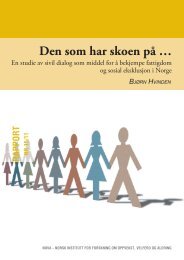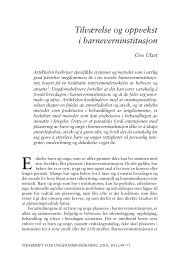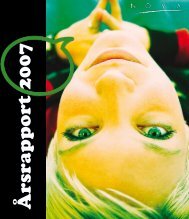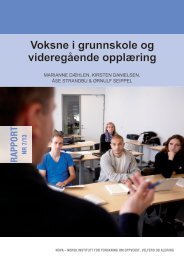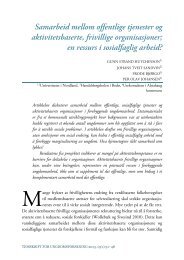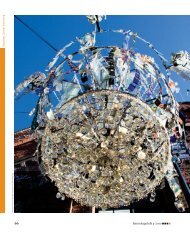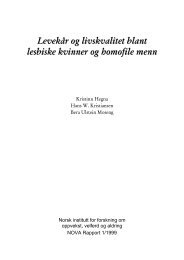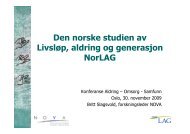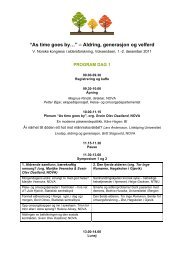Betydningen av seksuell erfaring, tiltrekning og identitet for ...
Betydningen av seksuell erfaring, tiltrekning og identitet for ...
Betydningen av seksuell erfaring, tiltrekning og identitet for ...
Create successful ePaper yourself
Turn your PDF publications into a flip-book with our unique Google optimized e-Paper software.
themselves as sexually attractive. Two heterosexual boys kissing at a party<br />
was much less common, and was more strongly linked to subcultural<br />
symbolism and to labelling an in-group as rebellious and daring, in<br />
opposition to the rest of the mainstream boys at the party. Thus, the<br />
homosexual kiss was interpreted in several ways: as ‘homosexual’, a symbol<br />
of rebellion, a simulation of sexual beh<strong>av</strong>iour and a simulation of a break<br />
with heteronormativity (Hegna & Larsen, Submitted; Larsen et al., 2005).<br />
Defined as ‘play’ and a game, such kissing may be normative beh<strong>av</strong>iour in<br />
some settings. However, a ‘real’ homosexual kiss is most likely nonnormative<br />
beh<strong>av</strong>iour among adolescents, and participants in this type of<br />
kissing in a public setting potentially run the risk of stigmatisation.<br />
In the current study, the group reporting homosexual beh<strong>av</strong>iour without<br />
attraction mainly comprised young people with homosexual kissing<br />
experience only. Their frequent alcohol use and good social integration<br />
could be explained as a consequence of a peer and party-oriented lifestyle,<br />
where the homosexual kissing experience characterises a group of (female)<br />
young people that are socially well integrated, popular among their friends<br />
and the young males who are the goal of their attractions. The normative<br />
party culture among Norwegian youth is still <strong>for</strong>emost a culture of alcohol<br />
use and binge drinking (Pedersen, 1998), which is in the same context as the<br />
homosexual kissing between two young women.<br />
Research on non-normative sexual activity has shown <strong>for</strong> instance that<br />
early sexual initiation is related to unconventionality and sensation seeking<br />
(Costa et al., 1995; Kalichman, Heckman, & Kelly, 1996; Kalichman,<br />
Tannenbaum, & Nachimson, 1998) and problem beh<strong>av</strong>iour in adolescence<br />
(Jessor, 1992). A propensity in young people to explore and to break<br />
normative barriers may be an underlying factor <strong>for</strong> both homosexual<br />
explorations as well as substance use. The finding that both alcohol and drug<br />
use is more widespread in both homosexual groups compared to the<br />
heterosexual group, indicates that unconventionality and non-normativity<br />
may be important <strong>for</strong> explaining more frequent substance use in both groups,<br />
as has been proposed by Bailey (1999). This should be investigated further<br />
in future studies.<br />
Homosexual attraction represents a more profound break with<br />
heteronormative socialisation, than homosexual experience in itself does.<br />
This break with heteronormativity may result in a feeling of being ‘different’<br />
and an outsider, and may lie behind the strong feeling of loneliness and<br />
disconnection reported by young people with homosexual attraction in this<br />
study. Moreover, homosexual attraction may be taken as an indication of<br />
– Homo? – 173




